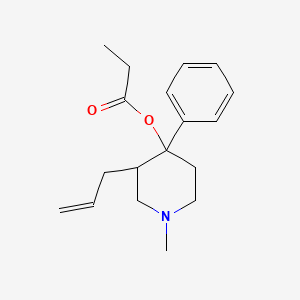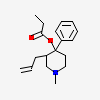Allylprodine
PubChem CID
32938
Molecular Formula
Synonyms
- Allylprodine
- Alperidine
- 25384-17-2
- Allilprodina
- Allylprodinum
Molecular Weight
287.4 g/mol
Computed by PubChem 2.2 (PubChem release 2021.10.14)
Dates
- Create:2005-03-27
- Modify:2025-01-18
Description
Allylprodine is a DEA Schedule I controlled substance. Substances in the DEA Schedule I have no currently accepted medical use in the United States, a lack of accepted safety for use under medical supervision, and a high potential for abuse. It is a Opiates substance.
ALLYLPRODINE is a small molecule drug with a maximum clinical trial phase of II.
Chemical Structure Depiction

(1-methyl-4-phenyl-3-prop-2-enylpiperidin-4-yl) propanoate
Computed by Lexichem TK 2.7.0 (PubChem release 2021.10.14)
InChI=1S/C18H25NO2/c1-4-9-16-14-19(3)13-12-18(16,21-17(20)5-2)15-10-7-6-8-11-15/h4,6-8,10-11,16H,1,5,9,12-14H2,2-3H3
Computed by InChI 1.0.6 (PubChem release 2021.10.14)
KGYFOSCXVAXULR-UHFFFAOYSA-N
Computed by InChI 1.0.6 (PubChem release 2021.10.14)
CCC(=O)OC1(CCN(CC1CC=C)C)C2=CC=CC=C2
Computed by OEChem 2.3.0 (PubChem release 2024.12.12)
C18H25NO2
Computed by PubChem 2.2 (PubChem release 2021.10.14)
9602 (DEA schedule I controlled substance)
- Allylprodine
- Alperidine
- 25384-17-2
- Allilprodina
- Allylprodinum
- Aliprodina
- Allilprodina [DCIT]
- alilprodina
- Ro 2-7113
- Aliprodina [INN-Spanish]
- Allylprodinum [INN-Latin]
- NIH 7440
- UNII-4343OEZ18O
- Allylprodine [INN:BAN:DCF]
- DEA No. 9602
- 4-Piperidinol, 1-methyl-4-phenyl-3-(2-propenyl)-, propanoate (ester)
- ACSCN-9602
- IDS-NA-007
- 4-Piperidinol, 3-allyl-1-methyl-4-phenyl-, propionate (ester)
- DTXSID80865210
- 4343OEZ18O
- NIH-7440
- 3-Allyl-1-methyl-4-phenyl-4-propionyloxypiperidine
- Allylprodine (INN)
- alpha-3-Allyl-1-methyl-4-phenyl-4-propionoxypiperidine
- Propionic acid, 3-allyl-1-methyl-4-phenyl-4-piperidyl ester
- Aliprodina (INN-Spanish)
- ALLYLPRODINE [INN]
- Allylprodinum (INN-Latin)
- .alpha.-3-Allyl-1-methyl-4-phenyl-4-propionoxypiperidine
- 1-Methyl-4-phenyl-3-(2-propenyl)-4-piperidinol propanoate
- 1-methyl-4-phenyl-3-(prop-2-en-1-yl)piperidin-4-yl propanoate
- (1-methyl-4-phenyl-3-prop-2-enylpiperidin-4-yl) propanoate
- ALLYLPRODINE [MI]
- SCHEMBL24416
- CHEMBL2103995
- DTXCID60220868
- AKOS015842723
- DB01542
- D12662
- Q4062649
- 3-Allyl-1-methyl-4-phenyl-4-piperidinyl propionate #
Property Name
Property Value
Reference
Property Name
Molecular Weight
Property Value
287.4 g/mol
Reference
Computed by PubChem 2.2 (PubChem release 2021.10.14)
Property Name
XLogP3
Property Value
3
Reference
Computed by XLogP3 3.0 (PubChem release 2021.10.14)
Property Name
Hydrogen Bond Donor Count
Property Value
0
Reference
Computed by Cactvs 3.4.8.18 (PubChem release 2021.10.14)
Property Name
Hydrogen Bond Acceptor Count
Property Value
3
Reference
Computed by Cactvs 3.4.8.18 (PubChem release 2021.10.14)
Property Name
Rotatable Bond Count
Property Value
6
Reference
Computed by Cactvs 3.4.8.18 (PubChem release 2021.10.14)
Property Name
Exact Mass
Property Value
287.188529040 Da
Reference
Computed by PubChem 2.2 (PubChem release 2021.10.14)
Property Name
Monoisotopic Mass
Property Value
287.188529040 Da
Reference
Computed by PubChem 2.2 (PubChem release 2021.10.14)
Property Name
Topological Polar Surface Area
Property Value
29.5 Ų
Reference
Computed by Cactvs 3.4.8.18 (PubChem release 2021.10.14)
Property Name
Heavy Atom Count
Property Value
21
Reference
Computed by PubChem
Property Name
Formal Charge
Property Value
0
Reference
Computed by PubChem
Property Name
Complexity
Property Value
362
Reference
Computed by Cactvs 3.4.8.18 (PubChem release 2021.10.14)
Property Name
Isotope Atom Count
Property Value
0
Reference
Computed by PubChem
Property Name
Defined Atom Stereocenter Count
Property Value
0
Reference
Computed by PubChem
Property Name
Undefined Atom Stereocenter Count
Property Value
2
Reference
Computed by PubChem
Property Name
Defined Bond Stereocenter Count
Property Value
0
Reference
Computed by PubChem
Property Name
Undefined Bond Stereocenter Count
Property Value
0
Reference
Computed by PubChem
Property Name
Covalently-Bonded Unit Count
Property Value
1
Reference
Computed by PubChem
Property Name
Compound Is Canonicalized
Property Value
Yes
Reference
Computed by PubChem (release 2021.10.14)
2.97
BIOBYTE (1995)
Standard non-polar
1929
NIST Number
248808
Library
Main library
Total Peaks
129
m/z Top Peak
172
m/z 2nd Highest
214
m/z 3rd Highest
170
Thumbnail
NIST Number
58724
Library
Replicate library
Total Peaks
83
m/z Top Peak
172
m/z 2nd Highest
214
m/z 3rd Highest
42
Thumbnail
Follow these links to do a live 2D search or do a live 3D search for this compound, sorted by annotation score. This section is deprecated (see here for details), but these live search links provide equivalent functionality to the table that was previously shown here.
Same Connectivity Count
Same Stereo Count
Same Isotope Count
Same Parent, Connectivity Count
Same Parent, Stereo Count
Same Parent, Isotope Count
Same Parent, Exact Count
Mixtures, Components, and Neutralized Forms Count
Similar Compounds (2D)
Similar Conformers (3D)
Gene Count
Substance
Allylprodine
DEA Controlled Substances Code Number
9602
Controlled Substances Act Schedule
Schedule I - Substances in the DEA Schedule I have no currently accepted medical use in the United States, a lack of accepted safety for use under medical supervision, and a high potential for abuse.
Class
Opiates
DEA Controlled Substances
DEA schedule I controlled substance
21 CFR Sections 1308.11-1308.15 https://www.ecfr.gov/current/title-21/chapter-II/part-1308
Patents are available for this chemical structure:
https://patentscope.wipo.int/search/en/result.jsf?inchikey=KGYFOSCXVAXULR-UHFFFAOYSA-N
- CAS Common ChemistryLICENSEThe data from CAS Common Chemistry is provided under a CC-BY-NC 4.0 license, unless otherwise stated.https://creativecommons.org/licenses/by-nc/4.0/
- ChemIDplusAllylprodine [INN:BAN:DCF]https://pubchem.ncbi.nlm.nih.gov/substance/?source=chemidplus&sourceid=0025384172ChemIDplus Chemical Information Classificationhttps://pubchem.ncbi.nlm.nih.gov/source/ChemIDplus
- DrugBankLICENSECreative Common's Attribution-NonCommercial 4.0 International License (http://creativecommons.org/licenses/by-nc/4.0/legalcode)https://www.drugbank.ca/legal/terms_of_useAllylprodinehttps://www.drugbank.ca/drugs/DB01542
- EPA DSSToxAllylprodinehttps://comptox.epa.gov/dashboard/DTXSID80865210CompTox Chemicals Dashboard Chemical Listshttps://comptox.epa.gov/dashboard/chemical-lists/
- ChEMBLLICENSEAccess to the web interface of ChEMBL is made under the EBI's Terms of Use (http://www.ebi.ac.uk/Information/termsofuse.html). The ChEMBL data is made available on a Creative Commons Attribution-Share Alike 3.0 Unported License (http://creativecommons.org/licenses/by-sa/3.0/).http://www.ebi.ac.uk/Information/termsofuse.html
- Drug Enforcement Administration (DEA)LICENSEUnless otherwise indicated, information on Department of Justice websites is in the public domain and may be copied and distributed without permission. Citation of the Department of Justice as source of the information is appreciated, as appropriate.https://www.justice.gov/legalpoliciesAllylprodinehttps://www.deadiversion.usdoj.gov/schedules/DEA drug and chemical classificationhttps://www.dea.gov/drug-information/drug-scheduling
- Open TargetsLICENSEDatasets generated by the Open Targets Platform are freely available for download.https://platform-docs.opentargets.org/licence
- Japan Chemical Substance Dictionary (Nikkaji)
- KEGGLICENSEAcademic users may freely use the KEGG website. Non-academic use of KEGG generally requires a commercial licensehttps://www.kegg.jp/kegg/legal.htmlTarget-based classification of drugshttp://www.genome.jp/kegg-bin/get_htext?br08310.keg
- Metabolomics Workbench
- NCI Thesaurus (NCIt)LICENSEUnless otherwise indicated, all text within NCI products is free of copyright and may be reused without our permission. Credit the National Cancer Institute as the source.https://www.cancer.gov/policies/copyright-reuseNCI Thesaurushttps://ncit.nci.nih.gov
- NIST Mass Spectrometry Data CenterLICENSEData covered by the Standard Reference Data Act of 1968 as amended.https://www.nist.gov/srd/public-lawAllylprodinehttp://www.nist.gov/srd/nist1a.cfm
- SpectraBase4-Piperidinol, 1-methyl-4-phenyl-3-(2-propenyl)-, propanoate (ester)https://spectrabase.com/spectrum/Gt3q3yljBHn4-Piperidinol, 1-methyl-4-phenyl-3-(2-propenyl)-, propanoate (ester)https://spectrabase.com/spectrum/AWcNVqYQSTK
- Springer Nature
- Wikidataallylprodinehttps://www.wikidata.org/wiki/Q4062649
- WikipediaPropylketobemidonehttps://en.wikipedia.org/wiki/PropylketobemidoneAllylprodinehttps://en.wikipedia.org/wiki/Allylprodine
- PubChem
- MolGenieMolGenie Organic Chemistry Ontologyhttps://github.com/MolGenie/ontology/
- PATENTSCOPE (WIPO)SID 388839933https://pubchem.ncbi.nlm.nih.gov/substance/388839933
- NCBI
CONTENTS

